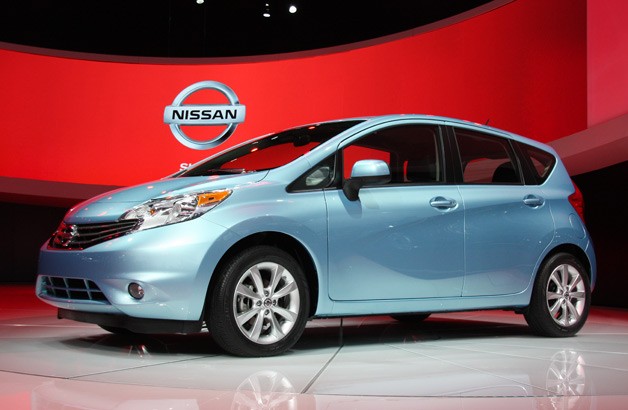The family sedan from the Japanese brand offers amazing habitability, generous trunk and interesting features, although it has some missing equipment and unattractive design.
The Nissan Versa is a compact sedan that the Japanese launched in Argentina in August 2013, after having presented at the last Motor Show Buenos Aires. It is a product that reaches the country imported from Mexico and it becomes the classic alternative to the typical family car, in this case with four distinct strengths: rear space, ride comfort, efficient mechanics and a decent trunk.
The Versa is essentially a compact model with segment dimensions but “enlarged” because it reaches a length to 4.46 meters, no less than 68 cm more than the hatchback. The wheelbase is extended by 15 centimeters to 2.60 meters, which further explains the exceptional livability.
The range of rivals of Versa is large, but probably the most direct, for dimensions and product concept, the Chevrolet Cobalt is another great habitability compact sedan, with 4.49 m long and 2.60 m wheelbase, and impressive trunk, with a record of 563 liters. Another possible nearest competitor for the Versa, but is smaller (4.29 m), is the Fiat Grand Siena.
The Versa is offered in Argentina in four versions, with prices valid until 10.02.14 ranging from $ 134,000 to $ 186,000. There are three trim levels, called Visia, Accent (manual and automatic) and Exclusive (auto only). The version we tested was the Accent M / T, which currently trades at $ 154,400 and is probably the most interesting feature of the range price-product.
Let’s put it bluntly: from our view that is entirely subjective, the Versa is not a self graceful design, especially in the rear view. Clearly displays lines that do not seem to be in tune with current trends in automotive design. But this is always debatable, personal taste, and in any case it is not a product that seeks to conquer by design, but by its aforementioned attributes.
The Versa offers correct quality fabrics inside and well embedded with rigid materials. For good, it shows that it is built in Mexico. The instrumentation combines analog gauges with digital and between them, including temperature gauge, something valued by many users, but is not as common in these times. The driving position is comfortable, with height adjustment of the seat and steering wheel. He also missing ball for the latter. The complex visibility is back: the bezel is very steep, the “tail” of the car is long and the headrests are not hidden when not in use. It is a bit complicated when parking, especially because it has no sensor, one of its major equipment shortages.
What strikes at first sight and then when tested in situ is the exceptional rear habitability. Indeed, the legroom is huge, even if tall people sit in the front seats. With 419 liters, the boot is not the biggest in the segment but is more than enough for a typical family baggage at holiday plan.
Under the hood hides the Versa March the same engine, gasoline engine 1.6-liter, 16-valve, associated with a 5-speed manual transmission, selector accurate but somewhat noisy in the passages. Although not a figure to impact, its 107 horses are more than sufficient to give an agile city performance and respectable performance on the road. Proof of this is that it accelerates the “0-100” in under 10 seconds (9.8 s according to our records), with a similar margin to recover from 80 to 120 km / h in 4th gear.
The consumption is logical and acceptable, with an average of 9.5 liters per 100 kilometers in the city and 8.5 liters/100 km at 130 km / h constant (motor runs at 3,800 rpm 5th). Precisely, to go on the road is when the Versa leaves cut out your family and why it is so nice to walk in your city with comfort-oriented suspension. Is required (and here we talk about the average by any user), shows marked inclinations body and occasional loss of traction. Also suffers enough with crosswinds. But ultimately, this does not imply that it is an unsafe car. And no one will look out for a run with Versa.
What is missing?
Safety features dual front airbags and ABS brakes, as required by the new regulations, and proposes a differential as the Isofix anchorages. If you have small kids, this is the best way to hold child seats (which must be compatible with the anchors, of course). While the Versa complies with because inertial and includes five three-point seatbelts, just lacks the 5th headrest, so it is halfway there. Another missing is the rear fog light.
In comfort, Acenta version offers cruise control, onboard computer, audio system with MP3-CD, auxiliary input, Bluetooth connectivity and steering wheel controls, internal tank and trunk release, mirrors and electric window lifter (“one touch” only for the driver and only descending), remote central locking and power assisted steering, softer than conventional hydraulic (its hardness varies depending on vehicle speed).
The Nissan Versa is one of those cars that do not catch the eye. However, it is also the kind that, once you experience them, may end up convincing. The Versa is honest and does not promise more than they can deliver. But if what you’re looking user is exactly what the proposed Versa, you’ll not disappointed. The 3 year warranty or 100,000 kilometers endorse products and a modernized Argentina Nissan Service Department of the Japanese is two strong pillars that reinforce the product.



